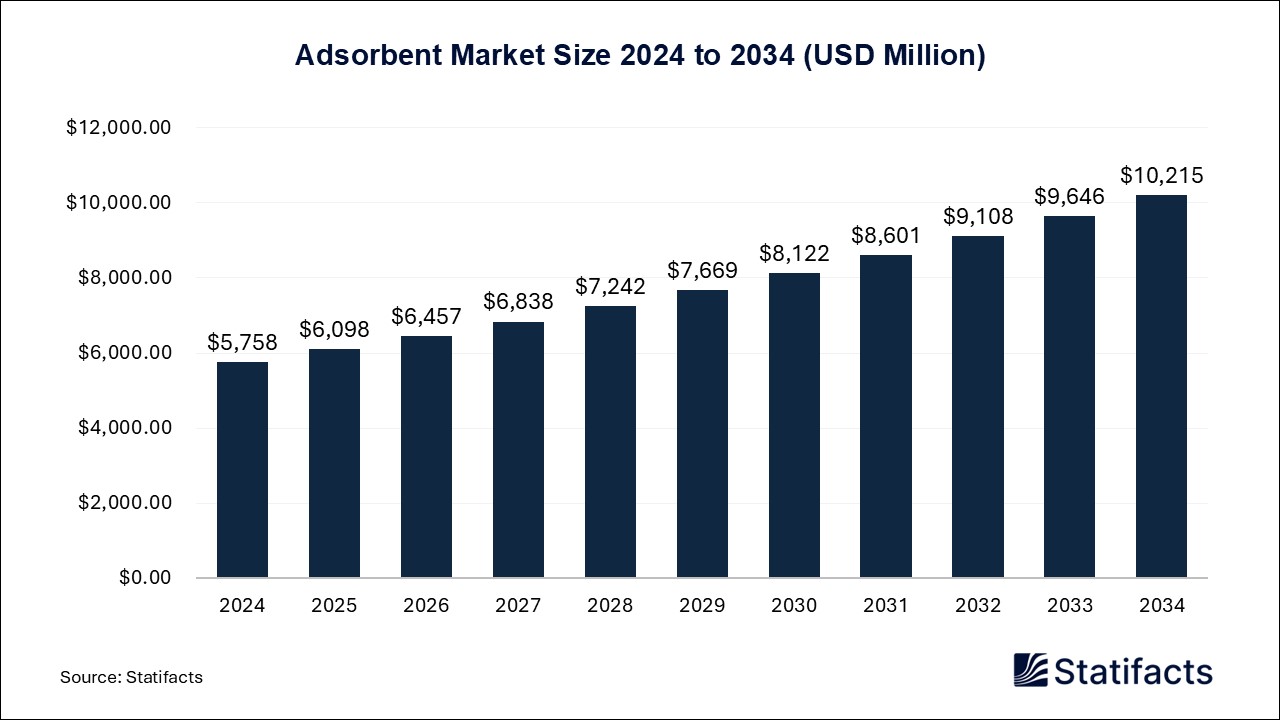
By clicking “Accept All Cookies” you agree to the storing of cookies on your device to enhance site navigation, analyze site usage, and assist in our marketing efforts.
Privacy PolicyHearing Aids Market (By Product Type: In-the-Ear Hearing Aids, Receiver-in-the-Ear Hearing Aids, Behind-the-Ear Hearing Aids, Canal Hearing Aids; By Technology: Digital, Analog; By Sales Channel: Retail Sales, Company Owned, Independent Retail, E-Pharmacy, Others; By Region: North America, Europe, Asia Pacific, Latin America, Middle East and Africa) Industry Size, Share, Growth, Trends 2025 to 2034.
The global hearing aids market size surpassed USD 14.1 billion in 2024 and is predicted to reach around USD 37.24 billion by 2034, registering a CAGR of 10.2% from 2025 to 2034.
| Industry Worth | Details |
| Market Size in 2025 | USD 15.54 Billion |
| Market Size by 2034 | USD 37.24 Billion |
| Market Growth Rate from 2025 to 2034 | CAGR of 10.2% |
The hearing aids market deals with sophisticated electronic devices that electronically amplify sound for people with hearing impairment of varied severity. The healthcare industry is a major and growing market for hearing aids, most notably in audiology and otolaryngology clinics. Hearing aids can be used by both children and adults with partial hearing impairment. Demand for hearing aids is increasing as awareness penetrates socially, and the introduction of favorable reimbursement policies, an increasing elderly population, especially in developed areas, has also increased demand.
Hearing Aids Market: Stats and Figures
The retail stores segment held a dominant presence in the market in 2024 as they provide personalized services, such as in-person consultations, hearing assessments, and professional fitting. These stores also elicit more customer trust, with the option to obtain products immediately and as well as in-store after-sales assistance, which is ideal for older and first-time users wanting to try before they buy in person.
The e-pharmacy sales segment is expected to grow at the fastest rate in the market during the forecast period of 2025 to 2034, from the penetration of the internet amongst consumers, the convenience of having products delivered to your home, and growing comfort in general with online purchasing.
The behind-the-ear hearing aids segment accounted for a considerable share of the market in 2024 due to their superior amplification, durability, and suitability across a broad spectrum of hearing loss levels, and also their ease of handling and also their ability to support advanced features such as Bluetooth, also have made the BTE design very popular especially amongst older adults.
The canal hearing aids segment is anticipated to grow with the highest CAGR in the market during the studied years on the basis of appearance (discreetness) and comfort. Recent improvements in technology have helped to make these small devices more powerful and customizable. This growth in convenient and aesthetically pleasing options also attracts younger consumers.
The digital hearing aids segment led the market in 2024 and is expected to grow at the fastest CAGR as they offer helpful features such as noise reduction, feedback cancellation, and sound adjustments for a specific environment. Their programmability is a significant factor in the hearing outcome, making them the most preferred for both audiologists and end-users for a long period of time.
The analog hearing aids segment is predicted to witness moderate growth in the market over the forecast period because they are less expensive and easier to use. They serve both cost-sensitive users and individuals who want something simple and uncomplicated, versus the digital hearing aid devices with features that they will never use, specifically for developing regions that have limited access to more advanced types of devices.
Europe
Europe dominated the market with the highest market share due to its demographic of elderly population, high level of awareness of hearing health, and established healthcare environments. Germany, the UK, and France have a large elderly population that acts as a very significant driver of hearing aid demand in Europe. Along with this, the region has favorable reimbursement policies for hearing care services and government involvement. There is also high acceptance and uptake of health innovation technologies in Europe, including strong interest in leading the adoption of digital and AI personal hearing aids. Furthermore, Europe has a strong history of early diagnosis via related newborn and adult hearing screening programs, which allows for hearing aids soon after. Hearing care services in Europe are continuously evolving and expanding, especially in terms of technology such as IoT and remote healthcare services.
Asia-Pacific
The Asia-Pacific region is expected to grow at the highest CAGR due to the growing proportion of the geriatric population, growing health care infrastructure, and healthcare professional and consumer awareness about hearing loss among the geriatric population, etc. Rapid urbanization in markets such as China, India, and Japan, and their growing middle class of patients from which demand for these devices is arising, all push the demand for hearing aids, their medical indications, and their supportive services. Furthermore, significant government awareness initiatives, improvement in telehealth and e-commerce channels are rapidly developing sales and distribution access, and even including remote populations in telehealth access to the local audiology experience.
The hearing aids market is highly competitive. Some of the key players in the market are Sonova, WS Audiology, Audicus, Audina Hearing Instruments, Inc., GN Hearing, GN Store Nord A/S, Horentek Hearing Diagnostics, MDHearing, and SeboTek Hearing Systems, LLC.
There are several companies in the market, but the prominent ones with a significant impact on the market are:
Sonova engages in the development and sale of hearing systems, which consist of digital hearing aids (Phonak, Unitron, Hansaton), cochlear implants (Advanced Bionics), wireless audio accessories, and services to the audiological care market in the medical device industry across more than 100 countries.
WS Audiology develops and distributes hearing aids, under brands such as Widex, Signia, Rexton, and online platforms such as hear.com.
GN Hearing, as a subsidiary of GN Store Nord, markets hearing aids under the ReSound, Jabra, Beltone, and Interton brands, and provides leading solutions for wireless and Bluetooth-enabled hearing aids.
| Regions | Shares (%) |
| North America | 35% |
| Asia Pacific | 30% |
| Europe | 25% |
| LAMEA | 10% |
| Segments | Shares (%) |
| In-the-Ear Hearing Aids | 30% |
| Receiver-in-the-Ear Hearing Aids | 25% |
| Behind-the-Ear Hearing Aids | 30% |
| Canal Hearing Aids | 15% |
| Segments | Shares (%) |
| Digital | 80% |
| Analog | 20% |
| Segments | Shares (%) |
| Retail Sales | 40% |
| Company Owned | 20% |
| Independent Retail | 20% |
| E-Pharmacy | 15% |
| Others | 5% |
Published by Kesiya Chacko
| Product Type | 2024 | 2025 | 2026 | 2027 | 2028 | 2029 | 2030 | 2031 | 2032 | 2033 | 2034 |
|---|---|---|---|---|---|---|---|---|---|---|---|
| In-the-Ear | 4.23 | 4.63 | 5.09 | 5.62 | 6.21 | 6.84 | 7.55 | 8.28 | 9.03 | 9.87 | 10.80 |
| Receiver-in-the-Ear | 3.53 | 3.88 | 4.28 | 4.73 | 5.22 | 5.73 | 6.28 | 6.88 | 7.50 | 8.18 | 8.96 |
| Behind-the-Ear | 4.23 | 4.67 | 5.12 | 5.67 | 6.24 | 6.87 | 7.57 | 8.30 | 9.05 | 9.82 | 10.74 |
| Canal | 2.11 | 2.35 | 2.62 | 2.81 | 3.03 | 3.30 | 3.56 | 3.91 | 4.42 | 5 | 5.49 |
| Technology | 2024 | 2025 | 2026 | 2027 | 2028 | 2029 | 2030 | 2031 | 2032 | 2033 | 2034 |
|---|---|---|---|---|---|---|---|---|---|---|---|
| Digital | 11.28 | 12.41 | 13.67 | 15.05 | 16.56 | 18.15 | 19.97 | 21.88 | 24 | 26.32 | 28.88 |
| Analog | 2.82 | 3.12 | 3.44 | 3.78 | 4.14 | 4.59 | 4.99 | 5.49 | 6 | 6.54 | 7.11 |
| Region | 2024 | 2025 | 2026 | 2027 | 2028 | 2029 | 2030 | 2031 | 2032 | 2033 | 2034 |
|---|---|---|---|---|---|---|---|---|---|---|---|
| North America | 4.94 | 5.46 | 6.04 | 6.67 | 7.36 | 8.08 | 8.86 | 9.64 | 10.50 | 11.48 | 12.59 |
| Asia Pacific | 4.23 | 4.69 | 5.16 | 5.70 | 6.27 | 6.87 | 7.54 | 8.20 | 8.99 | 9.86 | 10.83 |
| Europe | 3.53 | 3.88 | 4.27 | 4.70 | 5.18 | 5.70 | 6.30 | 6.88 | 7.50 | 8.12 | 8.96 |
| LAMEA | 1.41 | 1.50 | 1.64 | 1.76 | 1.89 | 2.09 | 2.26 | 2.65 | 3.01 | 3.40 | 3.61 |
| Subsegment | 2024 | 2025 | 2026 | 2027 | 2028 | 2029 | 2030 | 2031 | 2032 | 2033 | 2034 |
|---|---|---|---|---|---|---|---|---|---|---|---|
| In-the-Ear | 4.23 | 4.63 | 5.09 | 5.62 | 6.21 | 6.84 | 7.55 | 8.28 | 9.03 | 9.87 | 10.80 |
| Receiver-in-the-Ear | 3.53 | 3.88 | 4.28 | 4.73 | 5.22 | 5.73 | 6.28 | 6.88 | 7.50 | 8.18 | 8.96 |
| Behind-the-Ear | 4.23 | 4.67 | 5.12 | 5.67 | 6.24 | 6.87 | 7.57 | 8.30 | 9.05 | 9.82 | 10.74 |
| Canal | 2.11 | 2.35 | 2.62 | 2.81 | 3.03 | 3.30 | 3.56 | 3.91 | 4.42 | 5 | 5.49 |
| Subsegment | 2024 | 2025 | 2026 | 2027 | 2028 | 2029 | 2030 | 2031 | 2032 | 2033 | 2034 |
|---|---|---|---|---|---|---|---|---|---|---|---|
| Digital | 11.28 | 12.41 | 13.67 | 15.05 | 16.56 | 18.15 | 19.97 | 21.88 | 24 | 26.32 | 28.88 |
| Analog | 2.82 | 3.12 | 3.44 | 3.78 | 4.14 | 4.59 | 4.99 | 5.49 | 6 | 6.54 | 7.11 |
| Subsegment | 2024 | 2025 | 2026 | 2027 | 2028 | 2029 | 2030 | 2031 | 2032 | 2033 | 2034 |
|---|---|---|---|---|---|---|---|---|---|---|---|
| North America | 4.94 | 5.46 | 6.04 | 6.67 | 7.36 | 8.08 | 8.86 | 9.64 | 10.50 | 11.48 | 12.59 |
| Asia Pacific | 4.23 | 4.69 | 5.16 | 5.70 | 6.27 | 6.87 | 7.54 | 8.20 | 8.99 | 9.86 | 10.83 |
| Europe | 3.53 | 3.88 | 4.27 | 4.70 | 5.18 | 5.70 | 6.30 | 6.88 | 7.50 | 8.12 | 8.96 |
| LAMEA | 1.41 | 1.50 | 1.64 | 1.76 | 1.89 | 2.09 | 2.26 | 2.65 | 3.01 | 3.40 | 3.61 |
The market is being fueled by rapidly rising prevalence of hearing loss, particularly among aging populations and noise-exposed younger individuals, alongside broader insurance access, digital health tools, and rising consumer awareness.
Modern devices feature artificial intelligence for speech enhancement, Bluetooth connectivity for direct streaming, customizable smartphone apps, rechargeable batteries, and increasingly sleeker form factors produced using 3D-printing techniques.
FDA approval of over-the-counter (OTC) hearing aids has democratized access in the U.S., enabling self-fitting devices like AirPods Pro-based solutions, boosting affordability, and reaching mild-to-moderate users directly.
High device pricing, limited reimbursement coverage, insufficient audiology resources in many regions, and lingering social stigma, often delaying adoption, remain persistent challenges.
Emerging markets in Asia-Pacific and parts of Africa offer major growth potential. Innovations in tele-audiology, self-fitting OTC devices, and bundled digital offerings are expanding access and reshaping the hearing care landscape.
DNA Sequencing Market (By Product & Services: Consumables, Instruments, Services; By Technology: Sanger Sequencing, Next-Generation Sequencing, Whole ...
To get full access to our Market Insights, you need a Professional Account or a Business Suite.

You will receive an email from our Business Development Manager. Please be sure to check your SPAM/JUNK folder too.

You will receive an email from our Business Development Manager. Please be sure to check your SPAM/JUNK folder too.

Our customers work more efficiently and benefit from


